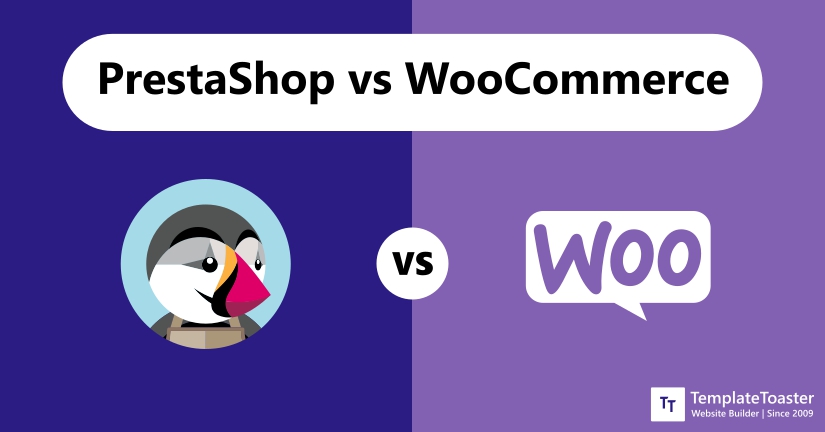PrestaShop vs WooCommerce: Which eCommerce Platform is Better?
Choosing the right eCommerce platform is crucial to the success of your online business. PrestaShop and WooCommerce continue to dominate the open-source eCommerce space, each with its unique strengths. Whether you’re a developer, small business owner, or enterprise-level merchant, this comprehensive comparison will help you make an informed decision.
PrestaShop vs WooCommerce: A Quick Overview
Here’s a quick side-by-side comparison to highlight the core differences between PrestaShop and WooCommerce:
| Feature | PrestaShop | WooCommerce |
|---|---|---|
| Ease of Use | Moderate | Easy (with WordPress familiarity) |
| Customization | High | Very High (via WordPress) |
| SEO | Good | Excellent |
| Security | Moderate | Strong (with plugins) |
| Cost | Moderate to High | Low to Moderate |
| Extensions | 4000+ modules | 50,000+ plugins |
| Support | Paid Plans | Community-driven |
| Performance | Fast (with optimization) | Depends on hosting |
Ease of Use
PrestaShop provides a robust and feature-rich admin dashboard, but its learning curve can be steeper for beginners. Installing Prestashop is straightforward, but configuring modules and customizing themes might require technical know-how. You can easily move Prestashop from localshot to live server. In contrast, WooCommerce benefits from WordPress’s user-friendly interface, making setup and store management intuitive for users of all levels.
If you’re comfortable with WordPress, WooCommerce will likely feel more natural. However, developers who prefer standalone platforms may lean toward PrestaShop for its deeper built-in commerce functionalities.
Customization and Design Options
Both platforms offer strong customization options, but they differ in approach. WooCommerce users can leverage page builders like Elementor and thousands of themes to craft unique storefronts. Additionally, the WooCommerce Theme Builder from TemplateToaster makes designing custom themes seamless. You can also explore how to create a custom WooCommerce theme for more control.
PrestaShop provides flexibility through modules and theme overrides. Designers and developers can use the PrestaShop Theme Maker or refer to this guide on how to create a PrestaShop theme. For quick solutions, explore free WooCommerce themes and free PrestaShop themes and templates.
Features and Functionality
PrestaShop comes packed with advanced eCommerce features out of the box, such as multi-store capabilities, multi-language support, and complex product management. These features make it ideal for businesses operating across regions.
WooCommerce, on the other hand, keeps things lean initially, but thanks to the WordPress ecosystem, virtually any functionality can be added via plugins. Whether it’s subscription models, booking systems, custom checkout flows or Dropshopping, WooCommerce has a plugin for it.

Performance and Scalability
Performance depends largely on hosting and optimization techniques. PrestaShop performs well even with larger product catalogs, especially when paired with a good server and caching mechanism. It supports multiple warehouses and stores, making it scalable for growing businesses. You need to have a solid hosting provider for Prestashop.
WooCommerce’s performance hinges on your WordPress setup. With proper hosting, CDN, and caching (e.g., WP Rocket, Cloudflare), it can scale impressively. However, it may require more optimization effort than PrestaShop for large-scale operations.
SEO Capabilities
WooCommerce excels in SEO, benefiting from the vast suite of WordPress plugins like Yoast SEO, RankMath, and All in One SEO. Users can easily optimize metadata, URLs, image alt texts, and XML sitemaps.
PrestaShop also offers solid SEO features, but advanced control may require additional modules. Its clean URL structure and Google-friendly tools are sufficient for most needs, but WooCommerce remains the more SEO-friendly platform overall.
Security
Security is essential for any eCommerce platform. WooCommerce, when paired with WordPress security plugins and regular updates, can offer strong protection against threats. It’s essential to secure plugins and use SSL and firewalls.
PrestaShop is generally secure but has seen more high-severity vulnerabilities in the past. Users need to ensure their modules are from trusted sources and keep their core and themes updated regularly.
Payment Gateways and Shipping
WooCommerce supports over 100 payment gateways, including PayPal, Stripe, Square, and local options. Shipping can be extended with WooCommerce Shipping and various plugins for advanced logistics.
PrestaShop also supports a wide array of payment solutions and offers solid shipping modules. However, some of the advanced features may come at a cost or require configuration effort.
Support and Community
PrestaShop offers official support plans, which can be pricey, but they ensure direct help. The PrestaShop community is active, though smaller than WordPress’s.
WooCommerce has massive community support thanks to WordPress. While it doesn’t offer direct customer service, forums, blogs, YouTube tutorials, and Facebook groups fill the gap. Premium plugin providers often include support as well.
Cost Breakdown
Both platforms are free to download and use, but costs can vary based on add-ons, themes, and hosting.
WooCommerce Costs:
- Hosting: $5–$30/month
- Themes: Free to $100+
- Plugins: Free to $300+
- Maintenance: Variable
PrestaShop Costs:
- Hosting: $10–$50/month
- Themes: Free to €150+
- Modules: Free to €300+
- Maintenance: Variable
WooCommerce vs PrestaShop: Pros and Cons
WooCommerce Pros:
- Seamless WordPress integration
- Excellent SEO capabilities
- Huge plugin ecosystem
- Easy to use and customize
WooCommerce Cons:
- Can become bloated
- Requires frequent updates
PrestaShop Pros:
- Powerful built-in eCommerce tools
- Multi-store and multi-language support
- Ideal for European markets
PrestaShop Cons:
- Less beginner-friendly
- Smaller community
Which Platform Is Best for You? [Use Cases]
- Best for Small Businesses: WooCommerce (easy to use, low entry cost)
- Best for International Stores: PrestaShop (built-in multi-language and currency)
- Best for Developers: PrestaShop (more granular control)
- Best for Content + Commerce: WooCommerce (content-rich sites)
Final Verdict: WooCommerce or PrestaShop?
Both platforms are excellent, but your choice should align with your specific business needs. Choose WooCommerce if you’re already in the WordPress ecosystem and want strong SEO and customization capabilities. Go with PrestaShop if you need advanced eCommerce features out of the box and plan to scale internationally. Check out Prestashop vs OpenCart ,WooCommerce vs Shopify, WooCommerce vs magento, migrate from PrestaShop to WooCommerce , OpenCart vs WooCommerce.
FAQs
Is WooCommerce better than PrestaShop for SEO?
Yes, WooCommerce benefits from WordPress’s powerful SEO plugins, giving it an edge.
Can I migrate from PrestaShop to WooCommerce?
Yes, there are tools and services available to help with migrating from PrestaShop to WooCommerce.
Which is cheaper: PrestaShop or WooCommerce?
WooCommerce often has a lower entry cost, but expenses can add up depending on plugin use.
Is PrestaShop good for large stores?
Yes, it handles large inventories well and supports multiple stores and warehouses.
Do both platforms support mobile responsiveness?
Yes, both support responsive themes and mobile-friendly designs.
Which platform is better for international stores?
PrestaShop offers better out-of-the-box multi-language and currency features.
Build a Stunning Website in Minutes with TemplateToaster Website Builder
Create Your Own Website Now
Woocommerce has better features according to prestashop.
I appreciate the balanced perspective. As someone building stores for clients, I’ve found PrestaShop to be powerful, but WooCommerce definitely wins in terms of flexibility and SEO.